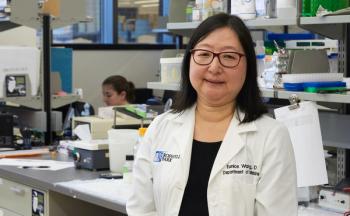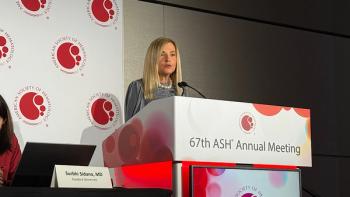
NIMH Efforts Seek Personalized Medicine Approaches to Prevent Brain Disorders
Thomas R. Insel, MD, the director of the National Institute of Mental Health (NIMH), started his talk with a grim picture of the nation's mental health: a January 2013 report from the Institute of Medicine found that mortality rates for US men and women under 50 years ranked last and near last, respectively, among 18 developed countries, with causes including car accidents, gun violence, and drug overdoses.
Thomas R. Insel, MD, the director of the National Institute of Mental Health (NIMH) looks and sounds like an optimist. So he gave pause to the capacity crowd Saturday at the 167th meeting of the American Psychiatric Association (APA) when he started his talk with a grim picture of the nation’s mental health: a January 2013 report from the Institute of Medicine found that mortality rates for US men and women under 50 years ranked last and near last, respectively, among 18 developed countries, with causes including car accidents, gun violence, and drug overdoses.1
Suicide rates in the United States are trending up, not down, Dr Insel said, in contrast with improving mortality measures almost everywhere else: a 63% reduction in deaths from heart disease over 4 decades, a 90% reduction in death rates from the most common childhood cancers, and the official relabeling of human immunodeficiency virus (HIV) as a “chronic disease,” a change that would have been unthinkable in the mid-1980s.
“The good news,” he said, “is that we have virtually doubled longevity in the last century. Only 100 years ago, life expectancy was measured in the 40s; now it’s in the 70s.” The reasons are public health and eradication of many contagious diseases, and biomedical science, which has allowed for prevention of heart attacks, strokes, and other life-threatening conditions.
“By comparison, in suicide, which 90% of the time involves a mental illness … we have not seen a similar drop,” Dr Insel said. “The suicide rate hasn’t budged at all. We see 38,000 a year, 4 an hour, 1 every 15 minutes.”
Yet Dr Insel’s lecture, “From Psychiatry to Clinical Neuroscience,” held in the Jacob K. Javits Convention Center in New York City, went on to forecast a bright future for treatment of what he called “brain disorders,” such as schizophrenia and bipolar disorder. The change will come, he said, because work happening now to understanding the genetic differences between a person with a healthy brain and one that goes on to develop a psychosis will revolutionize psychotherapy.
The same “personalized medicine” approaches that are changing cancer treatment—pairing the right drug with the right patient at the right time—will someday be deployed in mental healthcare. Instead of waiting for multiple psychotic episodes, or even 1, physicians will be able to identify and treat those whose family history, environmental, and genetic risk factors make them vulnerable to the most debilitating disorders.
Dr Insel went on to describe what he called “four inconvenient truths,” in laying out why neuroscience will be so important to psychiatry, and why it is the public health cause of the next generation.
Truth Number 1: In mental health, the United States has failed to bend the curve for morbidity and mortality.
“I am not proud of this, but I think we have to own this,” Dr Insel said. “When you look at morbidity, it is stunning … neuropsychiatric disorders are the largest single source of disability—almost 20% of the disability from all medical causes.”
What’s worse, he said, is that 75% of these illnesses onset before age 25, which is different from diseases like cancer or heart disease. “It’s very different … It’s amazing we aren’t talking about this more,” he said, echoing remarks made in a pre-meeting press briefing. There, APA president-elect Paul Summergrad, MD, noted that for all the attention paid to the so-called “young invincibles” during enrollment for the Affordable Care Act (ACA), “When it comes to mental health, the young are not so invincible.”
What’s the problem? Some would blame a “broken system,” or lack of access, but Dr Insel argued that’s not the root of the issue: “Our diagnoses are limited to observed symptoms and signs. That’s like defining the presence of heart disease by a myocardial infarction.”
Today, “there are no vaccines, no cures,” to prevent mental health disorders, and while studies may show effectiveness of a therapy on a population, individual response is highly variable. “It is still very much trial and error,” Dr Insel said.
Truth Number 2: More people are getting more of today’s treatment, but it’s not clear on a population basis that the outcomes are any better.
Even though 40% of the nation’s 11 to 17 million persons with serious mental illness do not receive care, Dr Insel said that data show more people are receiving treatment than ever, and more children are receiving care. More people are receiving Medicaid for a mental health disability than ever. However, among those who do get care, only about one-third will get better, Dr Insel said. That’s because by the time the best care is delivered, in a rehabilitation phase, it is often past the point where much good can be done. Intense care may come after a patient has become unemployable or committed a crime. In 44 out of 50 states, he said, the largest institution in which mental health treatment occurs is “a prison or a jail.”
“If we’re going to bend the curve, we have to not only improve access and quantity of care, but we also have to improve options and quality,” he said, which will require, “a very different approach. We have to figure out a way to rethink these disorders.”
A younger generation of physician-scientists, some of whom were trained as engineers, are using “big data” to study the wiring of the brain, in the same way that medicine knows how the heart pumps blood or the kidney processes waste. The tools that are being developed for this work are “transformative,” Dr Insel said. President Barack Obama’s BRAIN initiative, (Brain Research through
Advancing Innovative Neurotechnologies) is designed to fill in knowledge gaps on how neural circuits work.2 Data sets on 1200 people are about to become available for researchers, Dr Insel said.
“There is enormous mystery waiting to be unlocked,” he said. “In the next decade, we will have a much deeper understanding about how this organ works.”
Such an initiative is intertwined with the ACA because “people do recognize that we have a public health mandate; we are facing disorders that will bankrupt us.”
Projects underway include RAISE (Recovery After Initial Schizophrenia Episode), which aims to put intense treatment, job, and family support behind young patients after their first hospitalization for this debilitating disease. Typically, Dr Insel said, patients must experience multiple episodes and treatment failures before they can get intense services; yet, early use of these service is what will prevent the disease from progressing.
But until these efforts bear fruit, what can psychiatrists do?
Truth Number 3: Neuroscience is not ready for the clinic yet. We still don’t know enough to ensure prevention, recovery, or a cure for many people.
Still, the ACA will broaden access to coverage, and Dr Insel and others are hopeful that other provisions of the act, designed to encourage more collaborative models that will put mental health in partnership with primary care physicians, will bring care more quickly before disorders get worse, and before they result in other comorbid conditions.
And even after the role of neuroscience becomes clear, the answer might not be more or different medications. The answer might have more to do with social and job supports, or education for family members. An NIMH-supported project is laying the groundwork, he said.
Truth Number 4: Without better diagnostics, we may not be able to bend the curve.
The future lies in identifying those at risk of psychosis, Dr Insel said. The North American Prodrome Longitudinal Study (NAPLS) “has been on this path for a decade.”1 This effort involves imaging, identification of plasma biomarkers, and neurocognitive testing, along with family history. Dr Insel said that of the 400,000 “basement kids,” teenagers who isolate themselves, use marijuana, and have poor social skills, up to 100,000 will go on to experience a psychotic episode. NAPLS aims to give primary care physicians, school health officials, and mental health professionals tools to screen and identify those at risk, and intervene before an episode happens.
What will intervention look like? “You have to tune those circuits,” Dr Insel said. Most likely, there will be a suite of interventions, including cognitive training that would be tailored to a patient’s individual risk profile. “We need to develop better diagnostics and disseminate them,” he said. “The path to better mental health services is through science.”
References
- Insel T. The case for preemption. My Blog, Tom Insel MD, National Institute of Mental Health website. www.nimh.nih.gov. Published January 16, 2013. Accessed May 4, 2014.
- President Obama’s proposal to double federal funding for the BRAIN initiative [press release]. Bethesda, MD: March 11, 2014; National Institutes of Health website. www.nih.gov. Accessed May 4, 2014.
Newsletter
Stay ahead of policy, cost, and value—subscribe to AJMC for expert insights at the intersection of clinical care and health economics.









































